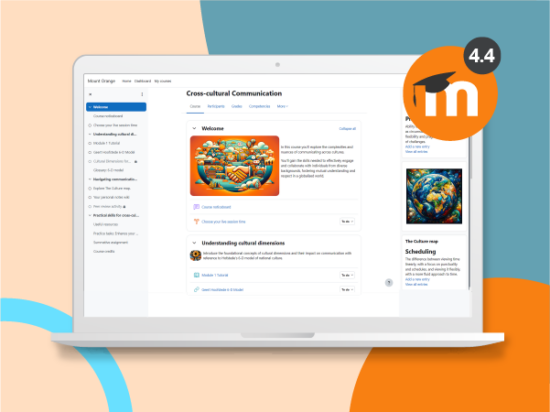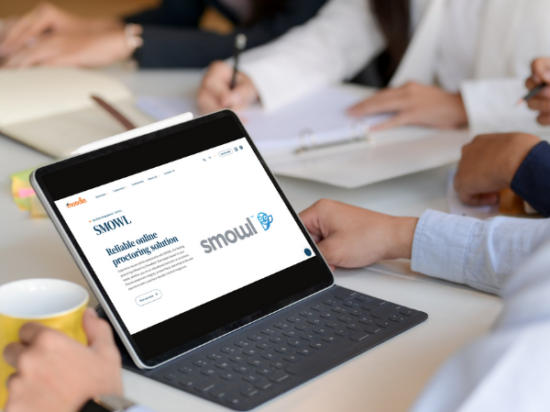In the current dynamic world of business, it is crucial to encourage a culture of constant learning within an organisation. As leaders, learning and development (L&D) professionals, hiring managers, and technologists, you have a significant role in identifying and utilising the potential of a powerful enterprise Learning Management System (LMS). An enterprise LMS efficiently manages eLearning content, keeping employees engaged and ensuring they perform to the best of their abilities.
However, despite your conviction in the benefits of implementing an enterprise LMS, gaining stakeholder buy-in for the project can be a daunting task. This is where building a compelling business case becomes crucial. When crafting it, it’s essential to lead with practical arguments that resonate with the stakeholders’ priorities. Highlighting how an LMS saves time and costs, streamlines processes, and enhances organisational efficiency can lay a solid foundation for your proposal. These are the factors that speak directly to the bottom line and operational effectiveness, making them compelling points to start with.
In this article, we will explore strategies and best practices for building a compelling business case for implementing an enterprise LMS. From understanding your stakeholders’ priorities to articulating the quantifiable benefits and addressing potential concerns, we’ll provide you with actionable insights to help you navigate the process successfully.
State the benefits of an enterprise LMS
Whether you are a hiring manager, technologist or L&D professional, you understand that a good LMS not only fulfils compliance obligations but also plays a pivotal role in developing essential skills, enforcing best practices, and addressing the engagement and retention challenges faced by your organisation. However, these benefits may not always be apparent to stakeholders who are removed from the intricacies of training program development.
Therefore, your challenge lies in crafting a persuasive proposal that effectively communicates the value proposition of investing in new technology. One such key benefit is saving on costs.
Saving on tangible and intangible training costs
Tangible costs refer to those directly measurable expenses incurred by an organisation, such as expenditures on training materials, instructor fees, and administrative overhead. With an LMS, companies can substantially reduce these costs by centralising training content, automating administrative tasks, and facilitating self-paced learning modules. In addition, LMS platforms also contribute to significant intangible cost reductions. Intangible costs contain factors that are not directly quantifiable but have a substantial impact on organisational performance and success, such as employee turnover, productivity loss, and inefficiencies in knowledge transfer.
Let’s take the example of how KLM Royal Dutch Airlines utilised Moodle Workplace to maintain an eLearning ecosystem that balanced flexibility, low Total Cost of Ownership (TCO), and seamless integration of new functionalities. In terms of tangible costs, Moodle Workplace enabled KLM to centralise training content and automate administrative tasks like course enrollment and progress tracking. This streamlined operations, significantly reducing administrative overhead costs associated with manual processes. KLM was able to eliminate the need for printed training materials, thus cutting down on material costs.
To reduce its intangible costs, the platform offered convenient and interesting learning opportunities, enabling employees to improve their knowledge and skills. As a result, job satisfaction and retention rates increased, which helped to manage the costs associated with employee turnover and loss of productivity.
Reporting and analytics
Enterprise LMS provides organisations with reporting and analytics tools, enhancing their capability to track and improve various aspects of employee training. These tools enable the monitoring of course completion rates, learner progress, participant satisfaction, and average course ratings, offering valuable insights into the training program’s effectiveness.
These metrics serve as key indicators, allowing stakeholders to assess performance trends over time and identify areas for improvement, irrespective of organisational scale. Organisations can use this analytics framework to customise training courses based on learners’ preferences and needs, resulting in higher engagement and knowledge retention.
Consistency and flexibility
With an enterprise LMS, organisations can ensure standardised delivery of training content across diverse geographical locations, ensuring that learners everywhere receive the same high-quality learning experience. This consistency is important for maintaining alignment with organisational standards and objectives, as it guarantees uniformity in knowledge dissemination and skill development regardless of cultural or linguistic differences. HR managers can streamline administrative processes, minimise discrepancies, and create a cohesive learning environment that transcends geographical boundaries by centralising training materials and delivery mechanisms within the LMS.
Moreover, the flexibility inherent in enterprise LMS platforms empowers HR managers, L&D professionals, and technologists to adapt training programs to meet evolving organisational needs and learner preferences. Through customisable features such as modular course structures, multi-format content support, and mobile accessibility, organisations can cater to diverse learning preferences and schedules while ensuring engagement and knowledge retention.
Explore higher employee satisfaction and retention rate
LMS provides immense support in retaining and upskilling employees, particularly in the context of addressing the evolving demands of “jobs of tomorrow”, such as the emergence of AI-related positions, including AI content creators, interface and interaction designers, and data curators, and ethics and government specialists. With these kinds of evolving jobs, organisations are prioritising a skills-first approach when it comes to building a productive workforce.
As the skills-first approach gains prominence, LMS platforms offer a strategic solution for L&D managers, hiring managers, technologists, and leadership to cultivate a workforce equipped with the necessary competencies. Organisations can shift focus from traditional recruitment and retention models to prioritise an individual’s skills and capabilities over qualifications or job history.
The landscape of technology, digitalisation, and sustainability necessitates continuous learning and upskilling initiatives to keep pace with evolving job roles and industry requirements. Enterprise LMS platforms, such as Moodle Workplace, facilitate this process by providing a centralised hub for delivering personalised training programs tailored to employees’ specific skill development needs. Designed for flexibility, Moodle Workplace can be customised according to the organisation’s size, structure, and needs while integrating seamlessly with your software ecosystem.
Through targeted learning paths, adaptive assessments, and interactive modules, Moodle Workplace empowers employees to acquire new skills and competencies relevant to emerging roles and industry trends. Moreover, you can create learning journeys for your staff by combining different courses into learning programs and rewarding their progress and achievements with custom certifications.
Focus on scalability
A scalable LMS can easily adapt to evolving needs and increasing demands of organisations while maintaining performance and stability. As organisations expand, the necessity for an LMS that can grow in tandem becomes essential. Moodle Workplace, for instance, excels in this aspect, seamlessly accommodating rising user volumes while navigating through diverse learning landscapes. Moodle mitigates memory hoarding risks, guaranteeing consistent uptime and unwavering performance. With auto-scaling capabilities, Moodle eliminates scalability concerns altogether, maintaining responsive, uninterrupted learning experiences for every user, regardless of traffic volume fluctuations.
Organisations’ learning needs are constantly evolving, highlighting the importance of adaptability in an enterprise LMS due to changes in industry trends, regulations, or strategic pivots. Moodle’s agility allows for effortless integration of new features, functionalities, and third-party applications, enabling organisations to stay responsive to evolving learning landscapes and aligned with their dynamic business needs. For L&D and hiring managers, as well as leadership, the assurance of Moodle’s scalability offers peace of mind, knowing that their learning infrastructure can evolve seamlessly alongside their organisation, regardless of its size or trajectory.
Demonstrate the LMS to stakeholders
When presenting a demonstration of an LMS to stakeholders, such as executives, board members, or other key decision-makers, it’s crucial to align the presentation with the strategic objectives and priorities of the organisation. Here are a few tips to keep in mind:
- Begin by framing the discussion around the overarching goals the LMS aims to address, such as improving employee performance, enhancing organisational agility, or driving innovation. Highlight how the LMS aligns with the organisation’s vision and mission, emphasising its potential to support talent development, cultivate a culture of continuous learning, and ultimately contribute to achieving business objectives.
- Provide a comprehensive overview of the LMS’s features and functionalities, focusing on how each aspect addresses specific pain points or challenges faced by the organisation.
- For hiring managers, emphasise the LMS’s role in streamlining the recruitment and onboarding process, showcasing features such as skills assessment tools and personalised onboarding modules that can help attract and retain top talent.
- L&D managers can then delve into the platform’s learning analytics and reporting capabilities, demonstrating how it enables them to track learner progress, identify skill gaps, and measure the effectiveness of training initiatives.
- Technologists should highlight the LMS’s compatibility with existing systems and its scalability to accommodate future technological advancements, emphasising integration capabilities and security features. It is important to note that having an enterprise LMS not only enhances efficiency for hiring managers, L&D managers, and technologists but also ensures seamless integration with existing workflows and robust security measures for safeguarding sensitive data.
Throughout the demonstration, emphasise the tangible benefits and potential ROI of implementing the LMS, drawing on case studies, testimonials, or pilot program results if available. Illustrate how the LMS has delivered measurable results in terms of improved employee performance, increased productivity, and reduced turnover rates in similar organisations or industries.



